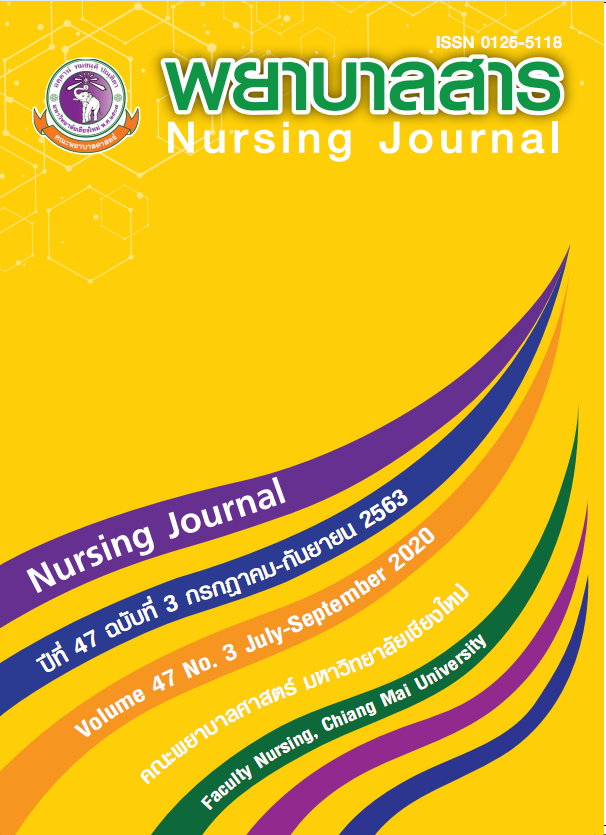Development of Empowerment Program for Patients with Osteoarthritis of Knees
Keywords:
Development Program, Health Promotion, Patient with Osteoarthritis of the KneeAbstract
Empowerment has been enhancing healing capacity and maintains the health of the patient. This development studies design aims to develop and trail to the results of empowerment programs. The sampling group was patients with all stages of Osteoarthritis diseases from the Out-Patient Department at tertiary hospital in Chiang Mai. A total of 36 people divided into 2 groups, measured before and after. The research instruments consisted of a sense of mastery and severity assessment form. Data were analyzed using descriptive statistics, Mann-Whitney U test, and Wilcoxon signed rank test. The results revealed that:
- Empowerment Program was Develop strategies based on Gibson's framework, consisting of three important parts which were: 1) The 4-step main program consists of discovering reality, critical reflection, taking charge and holding on 2) osteoarthritis guidebook and 3) an empowerment record
- The test of the empowerment program for osteoarthritis patients found that the participants of the empowerment program were the highest sense of mastery, and higher than those who did not participate in the program. Health outcome receiving the program, it was found that less severity of knee osteoarthritis than those who did not participate in the program with statistically significant (p < .05).
This program was effective for empowering patients with osteoarthritis for health promotion, a sense of mastery, and enhanced to their health.
References
Bellamy, N., & Buchanan, W. W. (1986). A preliminary evaluation of the dimensionality and clinical importance of pain and disability in osteoarthritis of the hip and knee. Clinical Rheumatology, 5(2), 231-241.
Bungearn, P. (2007). Effect of the Self-efficacy and Social Support Enhancement Program on Exercise Behavior among the Elderly with Knee Osteoarthritis. (ageing nursing). Graduate School Chiang Mai University, Chiang Mai. (In Thai).
Bunriang, P., Manirat, T., Nirat, I., & Suparb, A. (2014). Factors Related to Self-management Behaviors for Persons with Osteoarthritis. J Public Health, 42(2), 54-67. (In Thai).
Burns, N., & Grove, S. K. (2005). The practice of nursing research: Appraisal, synthesis, and generation of evidence. St. Louis, MO: Saunders Elsevier.
Gibson, C. H. (1993). A study of empowerment in mothers of chronically ill children. Boston College Dissertations and Theses, AAI9402789.
Gibson, C. H. (1995). The process of empowerment in mothers of chronically ill children. Journal of Advanced nursing, 21(6), 1201-1210.
Gibson, C.H. (1991). A concept analysis of empowerment. Journal of Advanced nursing, 16(3), 354-361.
Information and Health Information. (2017). Public Health Statistic A.D. June, 20, 2017. Retrieved from http://bps.moph.go.th/new_bps/ Public Health Statistic. (In Thai).
Nongpimol, N. (2014). The Epidemiological Situation and Risk Assessment of Knee Osteoarthritis among Thai People. Journal of The Royal Thai Army Nurses, 15(3), 185-194. (In Thai).
Panarat, J. (1999). Empowerment in Patient with Rheumatoid Arthritis. (ageing nursing). Graduate School Chiang Mai University, Chiang Mai. (In Thai).
Polit, D. F., & Hungler, B. P.(1995). Nursing research: Principle and method (6 Th). Philadelphia: Lippincott.
Roepke, S. K., & Grant, I. (2011). Toward a more complete understanding of the effects of personal mastery on cardiometabolic health. Health Psychology, 30(5), 615.
Silverman, M., Nutini, J., Musa, D., King, J., & Albert, S. (2008). Daily temporal self-care responses to osteoarthritis symptoms by older African Americans and whites. Journal of cross-cultural gerontology, 23(4), 319-337.
Vaewdow, T. (2000). Self-care Behavior and Severity of knee Osteoarthritis among the elderly. (ageing nursing). Graduate School Chiang Mai University, Chiang Mai. (In Thai).
Downloads
Published
How to Cite
Issue
Section
License
บทความที่ได้รับการตีพิมพ์เป็นลิขสิทธิ์ของวารสารพยาบาลสาร
ข้อความที่ปรากฏในบทความแต่ละเรื่องในวารสารวิชาการเล่มนี้เป็นความคิดเห็นส่วนตัวของผู้เขียนแต่ละท่านไม่เกี่ยวข้องกับมหาวิทยาลัยเชียงใหม่ และคณาจารย์ท่านอื่นๆในมหาวิทยาลัยฯ แต่อย่างใด ความรับผิดชอบองค์ประกอบทั้งหมดของบทความแต่ละเรื่องเป็นของผู้เขียนแต่ละท่าน หากมีความผิดพลาดใด ๆ ผู้เขียนแต่ละท่านจะรับผิดชอบบทความของตนเองแต่ผู้เดียว






